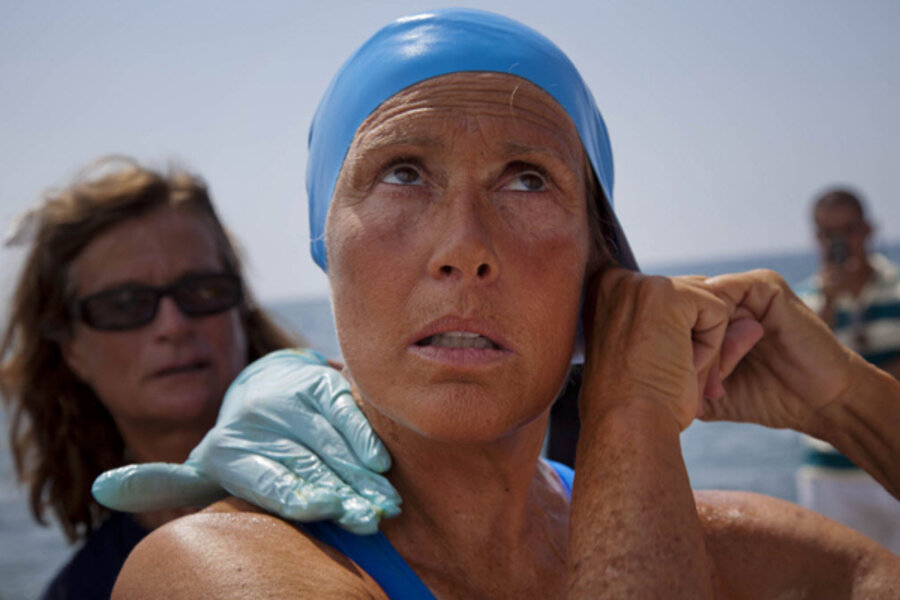62-year-old woman swimming strong in her attempt to cross the Florida Straits
Loading...
| Havana
American Diana Nyad endured several jellyfish stings as the 62-year-old endurance athlete sought to become the first person to swim unaided from Cuba to Florida without a wetsuit or a shark cage.
A team member posted on Nyad's Twitter account that the American was steadily stroking onward early Sunday despite jellyfish stings to the lips, feet and legs. Her goal: to become the first person to set a record 103-mile (166-kilometer) unaided crossing of the Florida Straits.
"There are so many jellyfish," said one of the tweets, adding, "Diana is swimming backstroke right now leading with the cap-covered part of her head to minimize contact."
While sharks were among Nyad's concerns along with potentially treacherous currents and surprise weather changes, jellyfish that tend to surface at night were a worry, her team signaled. Another tweet said there were jellyfish particles everywhere in the water as Nyad swam through the night. The tweet added that "the backstroke is working!"
Nyad, who is less than a week shy of her 63rd birthday, jumped into the warm waters near Havana on Saturday in her latest bid to make the crossing since last summer, when first an asthma attack and then jellyfish stings forced her to abandon separate attempts.
Australian Susie Maroney used a cage when she swam across the Straits of Florida in 1997.
Just before departing Saturday afternoon, Nyad spoke of how the monotony and sensory deprivation of marathon swimming is most intense at night, leading the mind down contemplative paths.
"I do enjoy, when I stop in the middle of the night and I see the stars, you start thinking out there," she said. "It becomes very metaphysical. ... You're tired and you've been having this metronomic stroke taking you into a different world, all of a sudden you're out there and you're thinking about the meaning of life and the grandeur of the universe and the mystery of it all."
There will be less time for introspective breaks this trip, however, as shifting forecasts showed Nyad's window of flat, calm seas threatening to slam shut a day earlier than expected.
That forced the go-time to be moved up nearly 15 hours to Saturday afternoon instead of around dawn Sunday, a time that had been chosen to minimize Nyad's exposure to the jellyfish that tend to surface more at night.
A member of Nyad's team posted an initial message on her Twitter account late Saturday saying the swimmer had been stung on the neck by a Flower Hat jellyfish. The second sting was to the lips, a later tweet said.
The third and fourth stings, to the hand and forehead, came from box jellyfish, the more dangerous variety that frustrated her last attempt.
This time Nyad had hoped a custom-made swimsuit would protect her from stings. It covers her head-to-toe with a pantyhose face and holes only for the eyes, nose and mouth.
A kayak-borne apparatus shadowing her in the water creates a faint electric field designed to repel most sharks, and a team of handlers was on alert to dive in and gently nudge away any that make it through.
Deeply tanned with freckles and goggle-eyes from long hours training in the sun, Nyad admitted to a minor case of nerves before departing Saturday. But she sounded confident.
"I feel really excited," she said. "I respect this. I know how difficult it is. There's a reason no one's ever done it, but I'm prepared. ... I may suffer some, but I'm prepared for that, too."
Nyad has been training for three years, and Stoll said she had a good 24-hour practice swim last week.
"We are in peak shape," Stoll said.
Nyad's team expected it would take at least 60 hours to complete the swim to the Florida Keys.
In June, Australian endurance swimmer Penny Palfrey made it 79 miles toward Florida before throwing in the towel in the face of strong currents.
A fiercely driven competitor, Nyad acknowledged it was hard to watch Palfrey come close to snatching away her long-held goal.
"If she had succeeded I would have congratulated her, because I know how difficult it is, more than anybody. And after all, this is not my ocean," Nyad said. "But it is my dream. ... Frankly - how can I lie? - I'm glad that I still have the chance to be first."
Nyad also tried to swim the straits as a 28-year-old in 1978 with the aid of a shark cage, but fell short.
Speaking with reporters Saturday, Nyad would not rule out another attempt should this one fail, but she seemed to acknowledge that even she has a limit.
"This Cuba swim obsession of mine, dating back to 1978 ... is at the last horizon," she wrote in an essay published on the Huffington Post.







